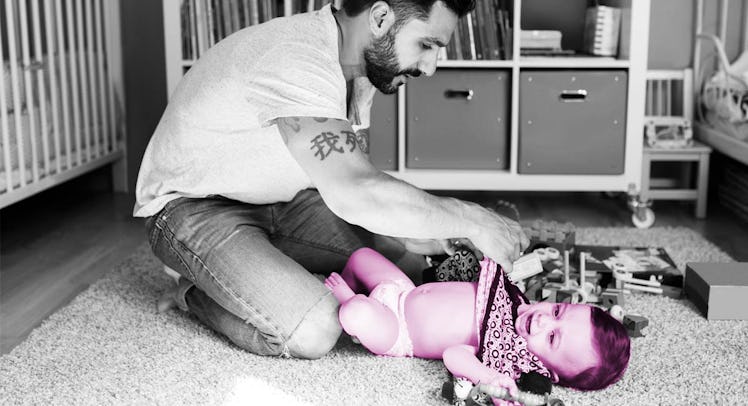How to Figure Out a Baby’s Diaper Size
Parents shouldn't simply be guided by size guidelines on diaper packaging. Sometimes there are better signs it's time to change diaper sizes.

Diapers are a lot like jeans: Sure, every brand of diaper comes in similar sizes, but a two in one brand seems like a four in another. Why does this matter? Not only do parents want their kids to be comfortable, they want to limit the risk of blowouts, which are more common when an undersized diaper is in play. The stakes are, as it turns out, high for parents trying to keep up with their child’s diaper situation.
READ MORE: The Fatherly Guide to Poop, Diapers, and Potty Training
“If your baby starts leaking a lot or soaking through, especially at night time, it might mean you need to move up to another size,” says Dr. Tanya Altmann, founder of Calabasas Pediatrics and author of Baby and Toddler Basics: Expert Answers to Parents’ Top 150 Question. “If you notice it’s getting too tight around the thighs or abdomen, and you’re seeing irritation from rubbing, that’s also a sign you need to move up to the next size diaper.”
Upgrading to a different size doesn’t just mean making space for a growing baby, it means adding more material to absorb, you know, whatever.
RELATED: The Best Diaper Bags For Dads
“If you have a dirty, explosive, leaking diaper once, you’re going to want to buy the next size,” says Altmann. “You have to change the clothes, wash everything, bathe the baby, and sometimes throw clothing away because it’s so disgusting you don’t want to wash it. So when you have one leakage, you (should) just go up a size.”
Unfortunately, there are also consequences to going up too early: The extra material can cause the diaper to droop, while the cuffs around the thighs end up being baggy, which can also result in leakage. Still, Altmann says that many parents may want to transition to a larger size at night to maximize absorption while sticking with a smaller size during the day when diaper changes are frequent.
“Often parents will move up to another size for nighttime because you’ll have extras of a smaller size they can wear during the day when you’re changing them more,” Altmann explains. “But at night when they’re sleeping all night long they need a bigger size.”
MORE: 10 Essential Diaper Changing Tips for New Parents
The directive is relatively straightforward: Purchase the correct size for a child’s age and weight and once the diaper becomes tight or starts leaking, move up a number. But diapers are complex feats of engineering, and nowadays no two diapers are the same. Selecting the right size and model (cruisers, swaddlers, etc…) in the first place can be an exercise in trial and error, and keeping up with the correct sizing can be confusing, especially when switching between brands.
“A standard diaper size three might be a different number in a different company, and we’re getting a lot of international diaper brands now: There is a biodegradable diaper from another country, and instead of six sizes like companies in the US do they have four,” says Altmann. “Even with major brands, they have different styles of the same size that fit differently.”
Even for brand loyalists, the transition from one size to the next can be rocky due to the fact that babies grow very differently, which could result in skipping a size or the necessity to switch brands to find one that fits the baby properly.
ALSO: The Anatomy and Functions of a Standard Baby Diaper
“Diapers, just like clothes and toys, come with suggested weights and ages. It’s always a good idea to look at the package. But some babies might be larger around the middle, or tall and skinny, and that’s when your baby might skew larger or smaller than you think,” says Altmann. “I usually tell parents you don’t want to stock too much on one size, especially newborn size because babies grow so rapidly that before you know it they’ve outgrown a size of the diaper.”
The key, therefore, might just be buying less. It’s frustrating, to be sure, but it’s workable in the age of Amazon Prime and way better than trying to co-exist with a ticking time bomb. And once parents are comfortable with the idea that their child is likely wearing the wrong size, they’ll be more responsive to signs that confirm this likelihood.
One important tip to go along with all that: It’s not a big deal. Having a baby in the wrong size diaper for a very long time is bad, sure, but it’s not likely to be dangerous unless its egregious and, in that sort of case, you’d definitely notice.
This article was originally published on